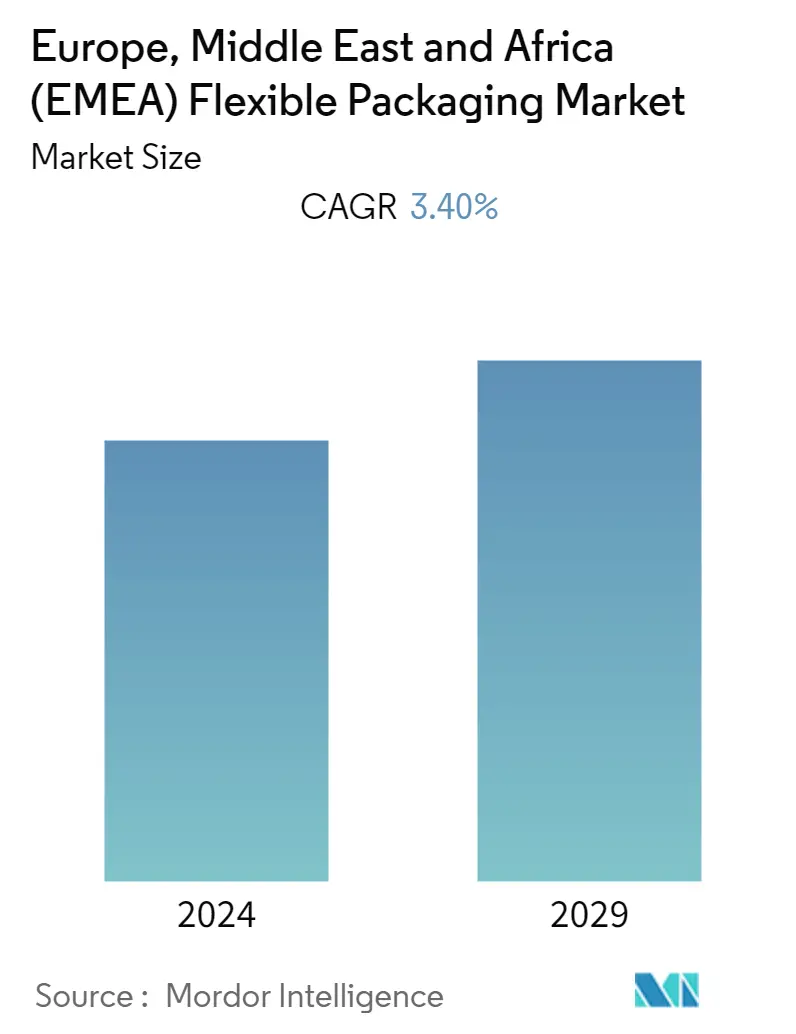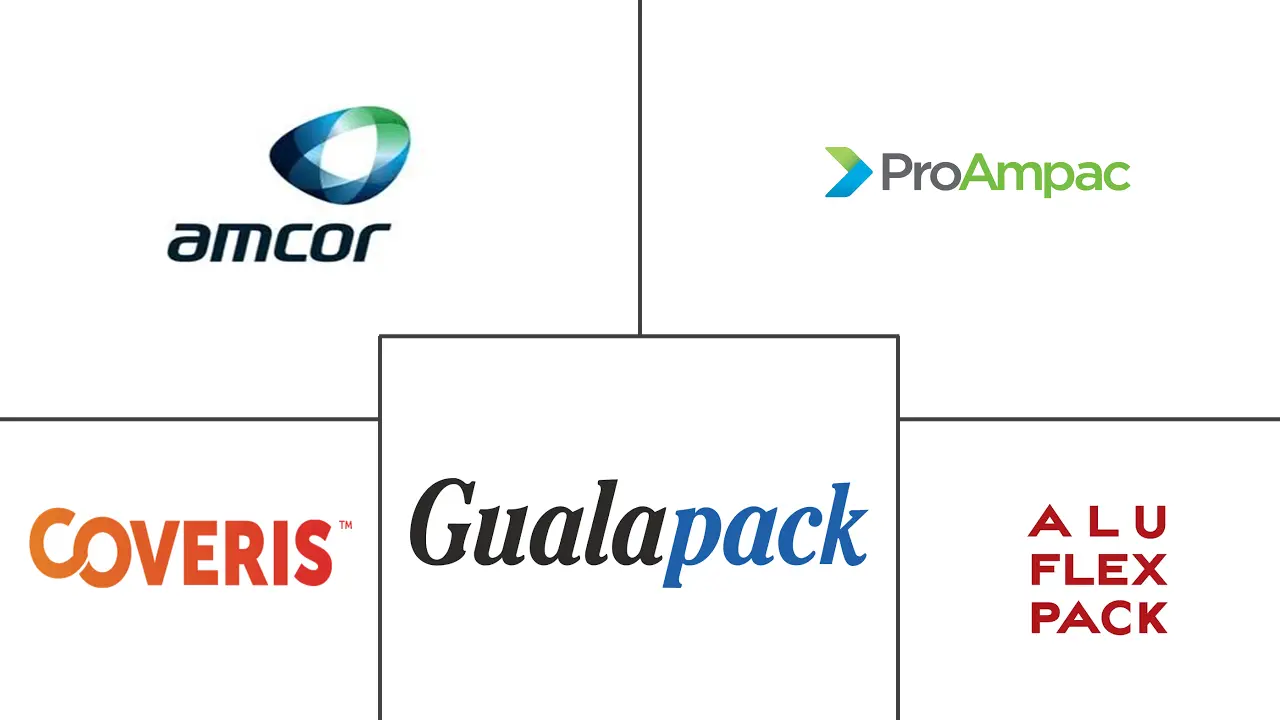Market Size of Europe, Middle East and Africa (EMEA) Flexible Packaging Industry

| Study Period | 2019 - 2029 |
| Base Year For Estimation | 2023 |
| CAGR | 3.40 % |
| Fastest Growing Market | Middle East and Africa |
| Largest Market | Europe |
| Market Concentration | Low |
Major Players
*Disclaimer: Major Players sorted in no particular order |
EMEA Flexible Packaging Market Analysis
Europe, Middle East and Africa (EMEA) Flexible Packaging Market was valued at USD 67.04 billion in 2020 and is expected to reach USD 81.11 billion by 2026, registering a CAGR of 3.4%, between 2021 and 2026. COVID-19 has led to bringing back single-use plastic bags rather than accepting reusable ones. For instance, Lush, a UK-based cosmetics retailer with a high percentage of packaging-free items, is being scrutinized by customers regarding how those products are picked and delivered to them. The pandemic is increasing the price of recycled plastic in Europe, as businesses reliant on the packaging are moving away from virgin materials. The price of virgin plastic decreased partly due to crude oil's price drop.
- Stand-up Pouches are witnessing significant demand and consumer interest in the region. The renewed interest in SUPs can be attributed to various factors, including the development of new packaging machinery, which delivers much higher production and filling speeds and improvements in sealing efficiencies. In addition, other technological advances have helped improve functionality and better heat and puncture resistance of the laminate material.
- Poland continues to have relatively strong growth, with exports accounting for around one-third of production. Regional imports are sourced majorly from Western European countries and growing from Asia and the Middle East.
- The end-user segment covers market developments and trends pertaining to food, beverage, pharmaceuticals, cosmetics, and other end-users. The increasing adoption rates in different end-users are majorly driven by the reduced complexities and ease of application during the post-pandemic period.
- Healthy growth for most end-user markets, such as coffee, pet food, and fresh foods, has driven production higher, according to the Flexible Packaging Europe (FPE). The continuing demand for more product varieties from consumers supports the general trend from rigid to flexible packaging, which offers greater convenience and fits better into today's lifestyle needs.
- However, the total cost of ownership for flexible packaging manufacturing is significantly higher in the region, which further acts as a barrier to entry to new entrants. The capital-intensive nature of the market, added with the increasing competition, is acting as a major market challenge in the current market scenario.
EMEA Flexible Packaging Industry Segmentation
Flexible packaging is one of the most prominent packaging techniques used by major vendors across a diverse range of end-user verticals. This is due to its superior quality, such as its extended shelf life. Further, it is one of the most economical packaging methods to distribute and preserve food, beverage, pharmaceutical products, and other consumables.
The study analyzes the demand for the flexible packaging industry across Europe, Middle-East, and Africa, based on the following segments:
Resin Type - Polyethene (PE), Biaxially Oriented Polypropylene (BOPP), Cast Polypropylene (CPP), Polyvinyl Chloride (PVC), PET and Other Material Types (EVOH, EVA, PA)
Product Type - Pouches, Bags, Films, and other Product Types.
End-user industry - Food, Beverage, Healthcare and Pharmaceuticals, Cosmetics and Personal Care and Other End-User Verticals
| Material Type | |
| Polyethene (PE) | |
| Biaxially Oriented Polypropylene (BOPP) | |
| Cast Polypropylene (CPP) | |
| Polyvinyl Chloride (PVC) | |
| PET | |
| Other Material Types (EVOH, EVA, PA, etc.) |
| Product Type | |||||||
| Pouches (Retort Pouches, Stand-up Pouches, and Flat Pouches) | |||||||
| Bags (Gusseted and Wicketed) | |||||||
| |||||||
| Other Product Types |
| End-User Verticals | ||||||
| ||||||
| Beverage | ||||||
| Healthcare and Pharmaceuticals | ||||||
| Cosmetics and Personal Care | ||||||
| Other End-user verticals |
| By Country | ||||||||
| ||||||||
| ||||||||
|
Europe, Middle East and Africa (EMEA) Flexible Packaging Market Size Summary
The EMEA flexible packaging market is experiencing a dynamic phase, driven by evolving consumer preferences and technological advancements. The shift from rigid to flexible packaging is gaining momentum, offering enhanced convenience and better alignment with modern lifestyle needs. Stand-up pouches are particularly in demand, fueled by innovations in packaging machinery that improve production efficiency and material resilience. The market is characterized by a diverse range of end-users, including food, beverages, pharmaceuticals, and cosmetics, with increasing adoption rates attributed to the ease of application and reduced complexities post-pandemic. However, the high total cost of ownership and capital-intensive nature of flexible packaging manufacturing pose challenges for new entrants, amidst growing competition.
Poland stands out as a significant market within the region, with robust growth driven by investments in advanced packaging solutions and a focus on environmentally friendly options. The country's flexible packaging market is supported by the expansion of manufacturing facilities and strategic acquisitions by major players, enhancing their geographical presence and product offerings. The demand for polyethylene and other resin-based packaging materials is expected to surge, supported by trends in reducing food waste and increasing adoption of recyclable films. Regulatory pressures, such as the plastic packaging tax, are influencing market dynamics, encouraging the adoption of recycled content and sustainable practices. The market remains fragmented, with numerous regional and global players contributing to its innovation and growth trajectory.
Europe, Middle East and Africa (EMEA) Flexible Packaging Market Size - Table of Contents
-
1. MARKET DYNAMICS
-
1.1 Market Overview
-
1.2 Market Drivers
-
1.2.1 Steady Rise in Demand for Processed Food
-
1.2.2 Move Toward Light Weighting Expected to Spur Volume Demand
-
-
1.3 Market Restraints
-
1.3.1 Flexible Packaging is Increasingly Turning into a Competitive Marketplace which could Impact the Growth Prospects of New Entrants
-
1.3.2 Environmental Challenges Related to Recycling, Although They are Expected to be offset by the Move toward Bio-based Products
-
-
1.4 Industry Supply Chain Analysis
-
1.5 Market Opportunites
-
1.6 Industry Attractiveness - Porter's Five Forces Analysis
-
1.7 Impact of COVID-19 on the Flexible Packaging Industry
-
-
2. MARKET SEGMENTATION
-
2.1 Material Type
-
2.1.1 Polyethene (PE)
-
2.1.2 Biaxially Oriented Polypropylene (BOPP)
-
2.1.3 Cast Polypropylene (CPP)
-
2.1.4 Polyvinyl Chloride (PVC)
-
2.1.5 PET
-
2.1.6 Other Material Types (EVOH, EVA, PA, etc.)
-
-
2.2 Product Type
-
2.2.1 Pouches (Retort Pouches, Stand-up Pouches, and Flat Pouches)
-
2.2.2 Bags (Gusseted and Wicketed)
-
2.2.3 Packaging Films
-
2.2.3.1 PE-based
-
2.2.3.2 BOPET
-
2.2.3.3 CPP and BOPP
-
2.2.3.4 PVC
-
2.2.3.5 Other Film Types
-
-
2.2.4 Other Product Types
-
-
2.3 End-User Verticals
-
2.3.1 Food
-
2.3.1.1 Frozen Food
-
2.3.1.2 Dairy Products
-
2.3.1.3 Fruits and Vegetables
-
2.3.1.4 Other Food Products
-
-
2.3.2 Beverage
-
2.3.3 Healthcare and Pharmaceuticals
-
2.3.4 Cosmetics and Personal Care
-
2.3.5 Other End-user verticals
-
-
2.4 By Country
-
2.4.1 Western Europe
-
2.4.1.1 United Kingdom
-
2.4.1.2 Germany
-
2.4.1.3 France
-
2.4.1.4 Italy
-
2.4.1.5 Spain
-
2.4.1.6 Rest of Western Europe
-
-
2.4.2 Eastern & Central Europe
-
2.4.2.1 Poland
-
2.4.2.2 Czech Republic
-
2.4.2.3 Romania
-
2.4.2.4 Hungary
-
-
2.4.3 Middle-East and Africa
-
2.4.3.1 Turkey
-
2.4.3.2 Rest of Middle-East
-
2.4.3.3 Africa
-
-
-
Europe, Middle East and Africa (EMEA) Flexible Packaging Market Size FAQs
What is the current Europe, Middle East and Africa (EMEA) Flexible Packaging Market size?
The Europe, Middle East and Africa (EMEA) Flexible Packaging Market is projected to register a CAGR of 3.40% during the forecast period (2024-2029)
Who are the key players in Europe, Middle East and Africa (EMEA) Flexible Packaging Market?
Amcor Ltd., Aluflexpack Group, Coveris Holdings, GualaPack SpA and ProAmpac LLC are the major companies operating in the Europe, Middle East and Africa (EMEA) Flexible Packaging Market.

